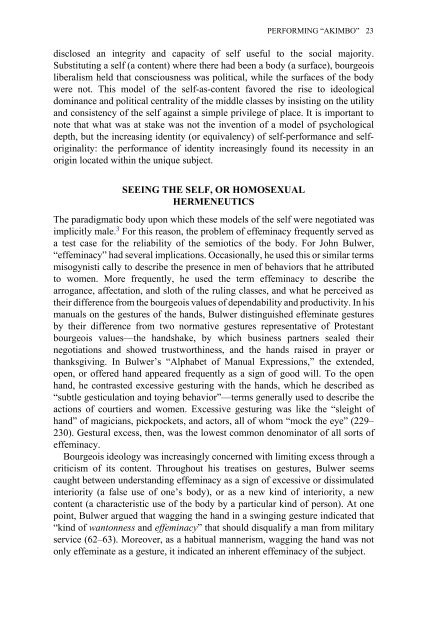Edited by Moe Meyer - Get a Free Blog
Edited by Moe Meyer - Get a Free Blog
Edited by Moe Meyer - Get a Free Blog
Create successful ePaper yourself
Turn your PDF publications into a flip-book with our unique Google optimized e-Paper software.
disclosed an integrity and capacity of self useful to the social majority.<br />
Substituting a self (a content) where there had been a body (a surface), bourgeois<br />
liberalism held that consciousness was political, while the surfaces of the body<br />
were not. This model of the self-as-content favored the rise to ideological<br />
dominance and political centrality of the middle classes <strong>by</strong> insisting on the utility<br />
and consistency of the self against a simple privilege of place. It is important to<br />
note that what was at stake was not the invention of a model of psychological<br />
depth, but the increasing identity (or equivalency) of self-performance and selforiginality:<br />
the performance of identity increasingly found its necessity in an<br />
origin located within the unique subject.<br />
SEEING THE SELF, OR HOMOSEXUAL<br />
HERMENEUTICS<br />
PERFORMING “AKIMBO” 23<br />
The paradigmatic body upon which these models of the self were negotiated was<br />
implicitly male. 3 For this reason, the problem of effeminacy frequently served as<br />
a test case for the reliability of the semiotics of the body. For John Bulwer,<br />
“effeminacy” had several implications. Occasionally, he used this or similar terms<br />
misogynisti cally to describe the presence in men of behaviors that he attributed<br />
to women. More frequently, he used the term effeminacy to describe the<br />
arrogance, affectation, and sloth of the ruling classes, and what he perceived as<br />
their difference from the bourgeois values of dependability and productivity. In his<br />
manuals on the gestures of the hands, Bulwer distinguished effeminate gestures<br />
<strong>by</strong> their difference from two normative gestures representative of Protestant<br />
bourgeois values—the handshake, <strong>by</strong> which business partners sealed their<br />
negotiations and showed trustworthiness, and the hands raised in prayer or<br />
thanksgiving. In Bulwer’s “Alphabet of Manual Expressions,” the extended,<br />
open, or offered hand appeared frequently as a sign of good will. To the open<br />
hand, he contrasted excessive gesturing with the hands, which he described as<br />
“subtle gesticulation and toying behavior”—terms generally used to describe the<br />
actions of courtiers and women. Excessive gesturing was like the “sleight of<br />
hand” of magicians, pickpockets, and actors, all of whom “mock the eye” (229–<br />
230). Gestural excess, then, was the lowest common denominator of all sorts of<br />
effeminacy.<br />
Bourgeois ideology was increasingly concerned with limiting excess through a<br />
criticism of its content. Throughout his treatises on gestures, Bulwer seems<br />
caught between understanding effeminacy as a sign of excessive or dissimulated<br />
interiority (a false use of one’s body), or as a new kind of interiority, a new<br />
content (a characteristic use of the body <strong>by</strong> a particular kind of person). At one<br />
point, Bulwer argued that wagging the hand in a swinging gesture indicated that<br />
“kind of wantonness and effeminacy” that should disqualify a man from military<br />
service (62–63). Moreover, as a habitual mannerism, wagging the hand was not<br />
only effeminate as a gesture, it indicated an inherent effeminacy of the subject.


